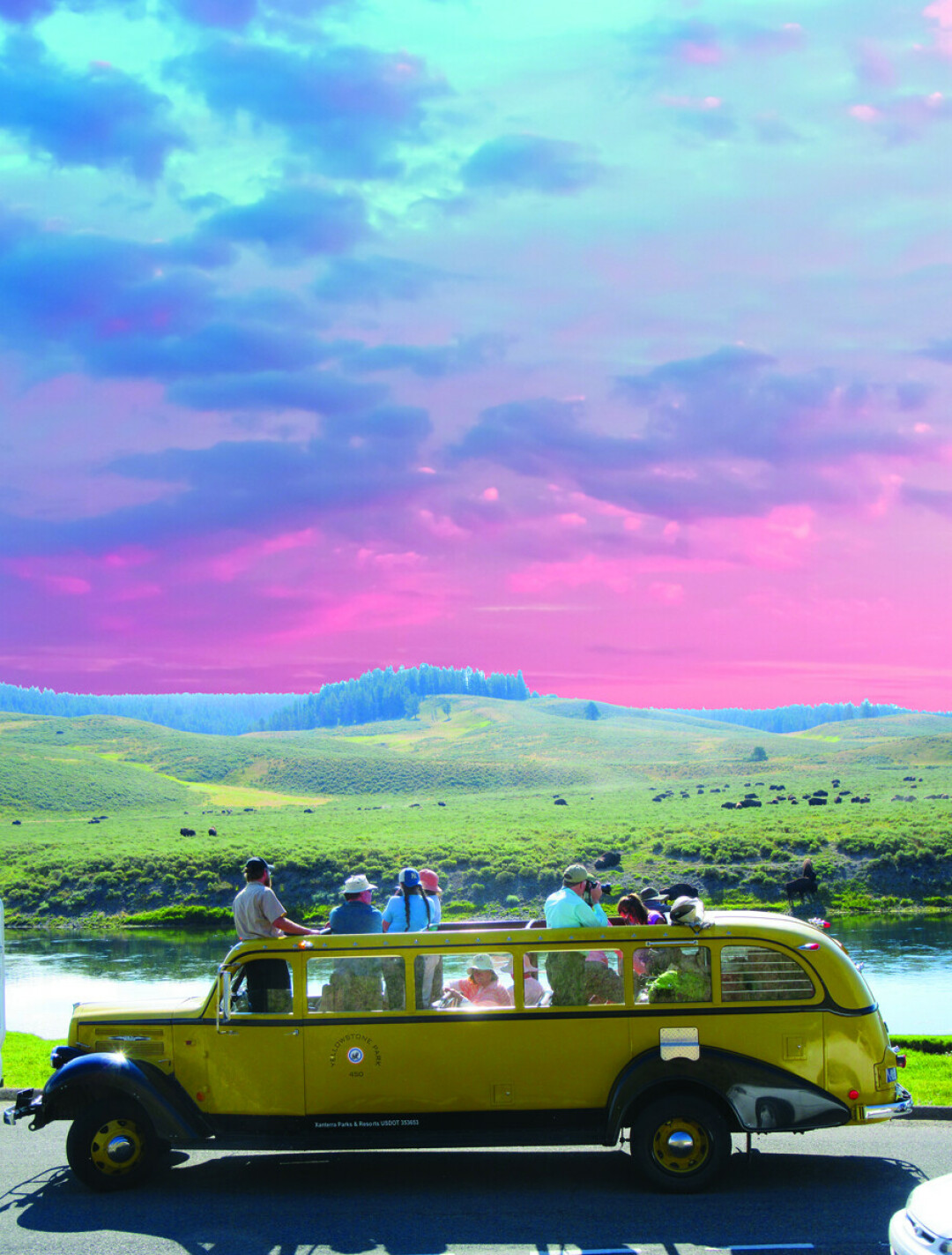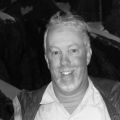40 Years of Yellowstone
Phil Knight | Saturday Apr. 1st, 2023
When I first came to Yellowstone, the park was only 110 years old. Now it is 151. Of those 41 years, I worked in or visited Yellowstone during all but one of them.
I arrived in the West by train in 1982, a total greenhorn, for my first summer of work in Yellowstone National Park. My brother Chris was the first of my immediate family to visit Yellowstone, on a cross country road trip in 1974, and he inspired me big-time. I applied to several parks by mail after graduating from college in Connecticut. Itching to explore the Wild West, I accepted a job as a dishwasher at the Lake Yellowstone Hotel. So much for using my college education. I arrived in mid-May to find Yellowstone Lake still frozen over, and snow everywhere. After three days washing dishes I was promoted to bus boy and, later, to waiter. That summer I made the most of my time off, hiking 400 miles with new friends and on my own, climbing peaks, dodging bison, exploring the park and getting hooked on this one-of-a-kind landscape. Phil Knight on the summit of Eagle Peak, Yellowstone's highest mountain. Photo by Ned Green.
Phil Knight on the summit of Eagle Peak, Yellowstone's highest mountain. Photo by Ned Green.
And I’m still here, still working in Yellowstone. Sometimes I have to pinch myself and think, “Yes, I work in the world’s first national park!” Like a lot of people, I was quickly hooked on the place and did not want to leave. I ended up working three summers at park hotels — one more summer at Lake (1983, when I was fortunate to live in a cabin at Fishing Bridge) and another at Mammoth (1985). In the intervening year, I worked trail crew in the White Mountain National Forest in New Hampshire and wintered over as caretaker of a remote hike-in hostel in the White Mountains.
A summer of waiting tables at Mammoth gave me the chance to explore more of the country surrounding the park, and I started to get to know the Greater Yellowstone Ecosystem (GYE). As I made ascents of Mount Cowen, Mount Wallace and other peaks, I was getting the sense that this was one wild and rugged region, and that here, lifetimes of exploration are to be had.
Following my summer at Mammoth, a friend invited me to check out Bozeman. I was soon convinced this was the town for me, and I have lived here ever since. My wife Alaina and I have greatly enjoyed our life here, have a home that is paid for and a wide network of friends.
Yellowstone has shaped my life in a variety of ways. For many years, the park was a promised land for adventure and challenge. When I lived and worked in the park, I had all kinds of opportunities to explore the backcountry. Having some backpacking and climbing experience from New England, I wasted no time applying those skills to the Yellowstone and Grand Teton country.
In 1982, I climbed a number of remote peaks with fellow employees. Three of us set out from the East Entrance Road after my girlfriend dropped us off at Sylvan Pass. We scrambled over Top Notch Peak and camped on a high ridge, then, the next day, climbed Mounts Langford, Doane and Stephenson (Doane is now known as First Peoples Mountain). We then bushwhacked out to Yellowstone Lake and hitchhiked back to Lake Hotel.
That same summer four of us backpacked twenty miles up Eagle Creek in Wyoming and climbed Eagle Peak, Yellowstone’s highest point. Only two of us tackled the tricky scramble to the summit. With one of those friends, Robert McDermott, I climbed the Grand Teton that summer as well. Later, I set out on a fifty mile, three day solo hike through Pelican Valley to Wapiti Lake and the remote Hot Springs Basin. Those solo miles had a profound impact on my self-confidence and backcountry skills. Backpacking alone in grizzly bear country is no joke, but it’s got its rewards.
My love affair with Yellowstone continued long after I moved to Bozeman. I found the unique combination of steaming hot springs, raging rivers, deep green forests, big mountains, crystalline lakes, large, dangerous wild animals, and solitude irresistible. Most of our family members and many old friends visited us over the years, and we always went to Yellowstone for fun and relaxation.
Into the Back of Beyond
My most ambitious solo hike took me one hundred miles through Yellowstone’s wildest corner. Hoping to visit the Thorofare country, I laid out an arduous one week journey starting and ending at the South Entrance. In 1989, the year after the Yellowstone fires, I went for it. This huge loop hike took me across the Snake River (chest deep) to Heart Lake, the South and Southeast Arms of Yellowstone Lake, into the upper Yellowstone River valley, over Two Ocean Plateau and Big Game Ridge and back to my starting point. I was nearly hobbled by tendonitis three days into the hike due to crummy boots, but was able to tape up my ankle and continue.
The Walk for Wild Yellowstone
I needed to get even deeper into the wilderness. In 1989, I’d met a very special lady, Alaina Lammer, who would become my wife. Somehow she agreed to join me for an epic journey – one we called the Walk for Wild Yellowstone. Seeking true immersion in wilderness hiking, and wanting an intimate knowledge of the ecosystem, our plan was to spend the entire summer backpacking a huge loop around the GYE. Months of planning, scrounging gear, and drying food followed. On July 1st, we locked our apartments for the summer and set out from Hyalite Canyon. Ten weeks later, weather-beaten, lean, woods wise and wild, we emerged at Pine Creek in Paradise Valley. Our feet had taken us through the most remote parts of the Gallatin, Madison, Teton, Gros Ventre and Absaroka mountains and into a few corners of Yellowstone Park. At 640 miles, it was the adventure of a lifetime. We were the first to backpack this route all in one trip. It also sealed our relationship, and in 1996 we were married.
Protesting Development
As a serious nature lover, I got involved in some campaigns to challenge some questionable management in Yellowstone. I also helped push for the reintroduction of wolves. The environmental groups I worked with protested in Yellowstone against overdevelopment of critical grizzly bear habitat. This was in the late 80s, when there were maybe one-third as many grizzly bears in the GYE as now. I was actually arrested at Fishing Bridge in 1988, wearing a bear suit! I also protested against snowmobile pollution in the park with a group of righteous women. We wore gas masks along the snowmobile road at the West entrance. A very frustrating campaign I’ve worked on for years and years is the mistreatment and killing of Yellowstone’s iconic bison.
Yellowstone and Shoshone Lakes
Yellowstone rivers, with one exception, are closed to boating and floating, but the park’s three largest lakes offer stellar canoeing and kayaking. Yellowstone and Lewis lakes are mostly open to motorboats, while Shoshone Lake is paddle power only. My wife and I received a canoe for our wedding gift from friends and family and have made several epic canoeing trips on these big, cold lakes. We’ve paddled the big southern “arms” of Yellowstone Lake, where there are no roads, and power boats are restricted. This is a wild and remote place, and the weather and cold water make you pay attention. Our three trips to Shoshone Lake have also been grand adventures, with one excursion ending in a snowstorm as we crossed the lake.
Twenty-two Peaks
To top off my expeditions in the vast Yellowstone region, I compiled a list of the highest mountain in every range in the GYE – 22 mountains in three states. My goal was to climb to each of these high points. My first one was Electric Peak, highest in the Gallatin Range, in 1982, and my last was Mount Fitzpatrick in the Salt River Range in 2020. In between, I joined friends or went solo to far-flung mountains in the Absaroka, Crazy, Wind River, Snowcrest, Gros Ventre, Madison, and many other ranges, allowing me to experience many spectacular corners of this incredible landscape.
Tour Guiding for Fun and Profit
Yellowstone became my workplace once again in 1999. I started guiding tourists in the park, utilizing my knowledge and understanding of the place to entertain and educate people. My first professional tours were in a snow coach to Old Faithful. Tour guiding there has been my main income ever since. I work year round, guiding wildlife watching and scenery trips, giving me the chance to make a living while experiencing the never ending nature show that is Yellowstone. From 2006 to 2016, I worked as an instructor for Yellowstone Association (now Yellowstone Forever). I’ve guided thousands of people while working for a variety of tour companies, and have seen hundreds of wolves, grizzly bears, and nearly all of Yellowstone’s wildlife species, though bobcats and lynx have so far eluded me. These days I work for Yellowstone Guidelines. Look us up!
These days, my wife and I are setting our sights on less physically demanding journeys, and generally enjoy a slightly slower life. But we often look around, gazing at the Spanish Peaks or the Tobacco Roots, and say, “Look where we live!” And Yellowstone still beckons — I will be there many times this year for work and play, and will keep going back as long as I am able. I hope you do, too.
| Tweet |
